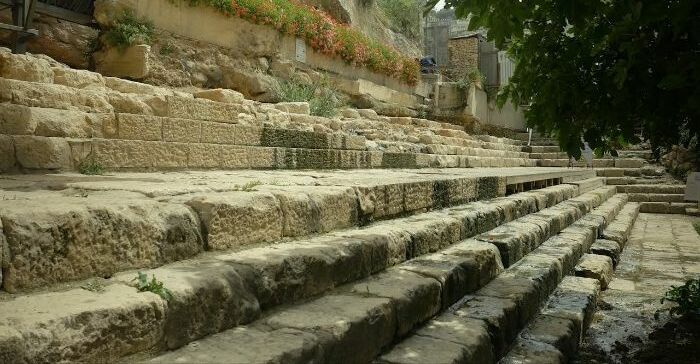THE SPRING OF JACOB
by Roger Wyatt | 2nd February 2020 | more posts on
'Messianic hope in the Hebrew Bible'| 0

Photograph: Todd Bolen/BiblePlaces.com.The stepped remains of the ancient Siloam Pool - redisovered in 2004!
When Jesus met the woman at the well, it wasn’t just any well, it was Jacob’s. Interestingly, the well is not mentioned anywhere in the Old Testament, and yet, by the time of Jesus it was clearly identified as belonging to the patriarch. Knowing how to find water, and dig wells, was a vital skill in the land of ancient Palestine – Abraham probably dug a well at Beersheba (modern Be'er Sheva) and Isaac certainly did: ‘That day Isaac’s servants came and told him about the well they had dug. They said, “We’ve found water!” He called it Shibah’ (Genesis 26:32-33a). Jacob, then, was following in the footsteps of his forefathers by digging the well. The Samaritan woman who talks with Jesus was not ignorant of the well’s historical significance: ‘Are you greater than our father Jacob, who gave us the well and drank from it himself, as did also his sons and his livestock?’ (John 4:12). Whilst there are no direct references in the Old Testament to the well at which the famous encounter took place there is perhaps an indirect one. Back in Genesis 49, as Jacob nears the end of his life, he prophesies over his twelve sons and his prophecy over Judah is rich with Messianic imagery - nowhere more than in verse ten:
‘the sceptre will not depart from Judah,
nor the ruler’s staff from between his feet,
until he to whom it belongs shall come
and the obedience of the nations shall be his.’
The suggestion of the passage is clear, someone was coming who would take up the sceptre of Judah and the ruler’s staff (symbols of kingly rule). This coming ‘he’ would, however, not just rule Judah but the nations. The text of the NIV hides the name given to this coming king, but he is identified as שִׁיל֔וֹ (Shiloh) in the Hebrew. It is a word of unknown origin but it used elsewhere in the Old Testament; Shiloh was the place chosen by Joshua, after the entrance of the Israelites into Canaan, to be the home of the tabernacle: ‘The whole assembly of the Israelites gathered at Shiloh and set up the tent of meeting there’ (Joshua 18:1). The tabernacle remained at Shiloh, according to Jewish tradition, for over three hundered years. Whilst this, at first sight, seems to have no significance to the mystery of Jacob’s well, it is of interest that when the temple is later built in Jerusalem it is built close to the waters of the one perennial spring in the city, הַשִּׁלֹ֔חַ (Shiloach). The waters of Shiloach or Siloam, as it became known, fed the ‘pool of Siloam’ - famous for the healing of the blind man that took place there. In fact the pool served an important purpose, and pilgrims arriving for the three major Jewish festivals would ceremonially wash in the waters before ascending the six hundred metres to worship at the temple (the pool was in fact the size of two Olympic swimming pools to allow for the enormous numbers of pilgrims).
The phonetic similarity between Shiloh and Shiloach is obvious (in fact the two words are the same but for the final sound – Shiloach ends with a more guttural ch). Moreover, it is fascinating that the two centres of Levitical worship in the history of ancient Israel share this word! Is it possible that Shiloh or Shiloach simply meant 'spring' or 'source', something so necessary for cleansing those arriving to worship? Could Jacob’s prophecy have been looking forward to the day the ‘the source’ would arrive? Certainly, Jesus’ encounter with the Samaritan woman seems to confirm this idea: ‘Jesus answered her, “If you knew the gift of God and who it is that asks you for a drink, you would have asked him and he would have given you living water”’ (John 4:10). Jesus is making it clear that he has the right to give away this living water and he is perhaps hinting at the fact that he was the one to whom the sceptre and staff would come, that he was Shiloh, the source or spring of life and that those who drank of this spring would thirst no more: ‘whoever drinks the water I give them will never thirst. Indeed, the water I give them will become in them a spring of water welling up to eternal life”’ (John 4:14). Indeed, if there was any ambiguity in Jesus’ claim up until this point, by the end of the conversation, none remains, for in response to the woman’s statement that one day the Messiah will arrive and make everything clear, Jesus declares, ‘I, the one speaking to you—I am he’ (John 4:26). As if to confirm this idea further, the discussion between Jesus and the woman swirls around the question of worship. Jesus is it seems presenting the idea that preparedness for worship is not a matter of washing or location, but rather is achieved through the reception of the living water, the Spirit of God. It is in receiving God’s Spirit that true worship is enabled, for ‘God is spirit, and his worshippers must worship in the Spirit and in truth’ (John 4:24).
The encounter at the well was then, perhaps, loaded with Messianic significance - the very well that the woman drew from prefigured the very man to whom she spoke, Jesus, Shiloh, the true spring of eternal life.
